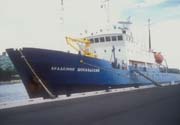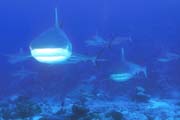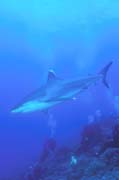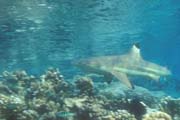|

001Moorea.jpg
|
“You’re not doing another one of those friggin’ shark trips, are you?” Thus spoke my docile wife when I informed her I’d decided on short notice to join a group on a liveaboard boat for the second half of April. “Oh no,” I quickly responded. “This is in French Polynesia. You know–majestic islands, beautiful reefs, pretty fish, topless French women–nothing to get excited about.” And this was all true (except for the topless women)–but there were also sharks, and plenty of them. Above is a shot of Moorea, one of the islands we stopped at toward the end of our trip. Most of our time was spent diving in the Tuamotu group, the largest of the five archipelagos that make up French Polynesia.
|
|

002AkademikShokalskiy.jpg
|
This is our boat, which we boarded in Papeete, the capital of French Polynesia, located on the island of Tahiti. We then proceeded 180 miles northeast to the Tuamotus, which are seventy-six islets and atolls spread out over more than 7,500 square miles. This was not a “usual” dive boat. It’s a 214 foot Russian icebreaker, making a stopover on its way back to Mother Russia after the ecotourism trips they run to Antarctica during the “good weather” summer (our winter) months. The guy who chartered the boat was there with his family from Australia, the expedition/dive coordinators on board were from New Zealand, the dive masters were from French Polynesia, most of the guests were American (with the notable exception of Australian dive gurus Ron & Valerie Taylor–they filmed “Blue Water, White Death” released back in 1971), and the entire crew (about 40 people, who spoke no English) was Russian. The boat was extremely comfortable, the food and service excellent, and the air conditioning kept at a perfect temp (often too hot or too cold on liveaboard boats).
|
|

003Many_Divers.jpg
|
Now we come to the problem. Just about any dive boat I’ve signed up for usually has 6-12 passengers. Obviously, a boat and crew of this size needs more guests to be economically feasible. We had 31 guest divers. On a given dive there would also be 2-3 divemasters and 3-5 crew diving, ferried to the dive site in five inflatables. The usual way to keep from overcrowding any one dive site would be to spread the inflatables around to different locations, switching around during the day. However, the nature of many of our dives made it necessary for ALL of us to be diving at the same site at one time. A big attraction here is doing “pass dives.” A typical atoll is a ring of coral rising some 3,000 feet from the ocean depths and circling a sheltered lagoon some 40-60 feet deep. Passes are gaps in the atolls through which large volumes of water flow into the lagoon on the incoming tide, creating strong currents. Large numbers of sharks are attracted to the passes at this time due to the extensive marine life which is there feeding on the nutrient-rich racing current. There was usually one desirable pass at whatever atoll we were at, and time was limited in order to catch the incoming tide at its peak, thus creating the dive cluster as shown above.
|
|
There was also the occasional manta or hawksbill turtle, even a large anchor off Apataki Atoll at a site called, appropriately enough, Anchor Corner.
|
|

0012Divers&Sharks.jpg
|

0013GrayReefSharks.jpg
|
|

0014GrayReefSharks.jpg
|

0015GrayReefSharks.jpg
|
Here was the big attraction–schools of up to 100 gray reef sharks getting up close and personal during our “pass dives” on the incoming tide. Getting a decent photo of these sharks was challenging, however. First, the passes tended to be narrow, maybe 100 feet, so almost 40 divers were crowded together. Second, we sometimes faced 4-6 knot currents due to the incoming tide, so you needed a spot where you could hunker down or the “drift” portion of your dive into the lagoon would start earlier than you had planned. Third, herding sharks into a pleasing composition for a photo is a lot like herding cats, except the teeth are bigger. Finally, the sharks would come to us swimming against the current, following the scent of the bait the divemasters would bring down with them. Naturally, in addition to the scent of the bait, the bubbles from all the divers were flowing down current due to the strong tide. So you can see that photos without arms, legs, fins or bubbles in them were hard to come by.
|

0016SilvertipShark.jpg |

0017BlacktipReefShark.jpg |
|
We saw other species of sharks as well, although I had no close passes from silvertips, and the young blacktips we saw tend to stay in water about one foot deep, limiting your mobility. I got much better silvertip stuff during my previous visit to French Polynesia at Rangiroa in September, 2001 (yes, that’s where I was during 9/11). You can view them by going to http://www.seaimages.org and clicking on “Photo Examples” then “Sharks” then “Silvertip Sharks”. I recently had Bill Prentiss, my computer consultant, add quite a few shark images to my site and arrange them into 19 species.
|

0018EdCallan.jpg |
|
I’m not much for people photography, but I had to include this one of fellow dive guest Ed Callen. Ed did all the dives, including the high-voltage, high-current pass dives. Ed is 84 years old, and my new hero.
|
That’s it for this trip folks! Best to all,
Ken
|